The Top 14 Chinese Ceramics Sold in 2016 at Bonhams

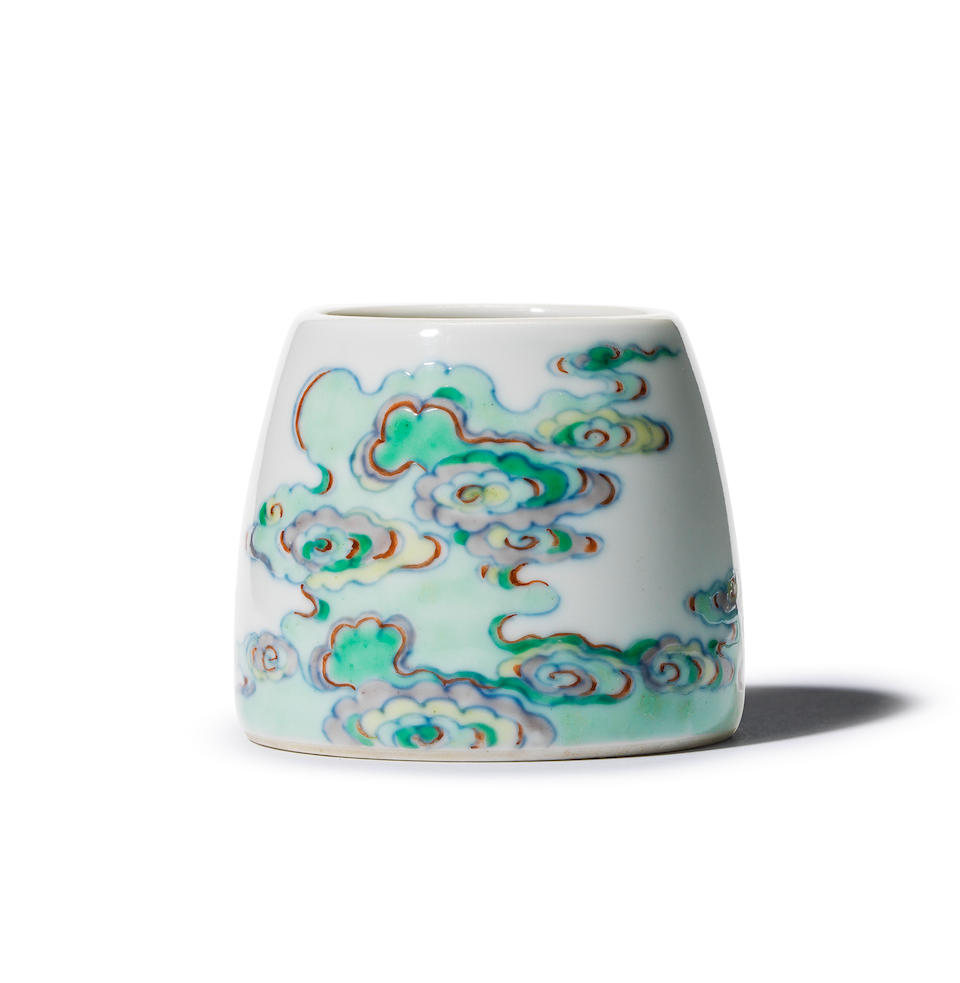

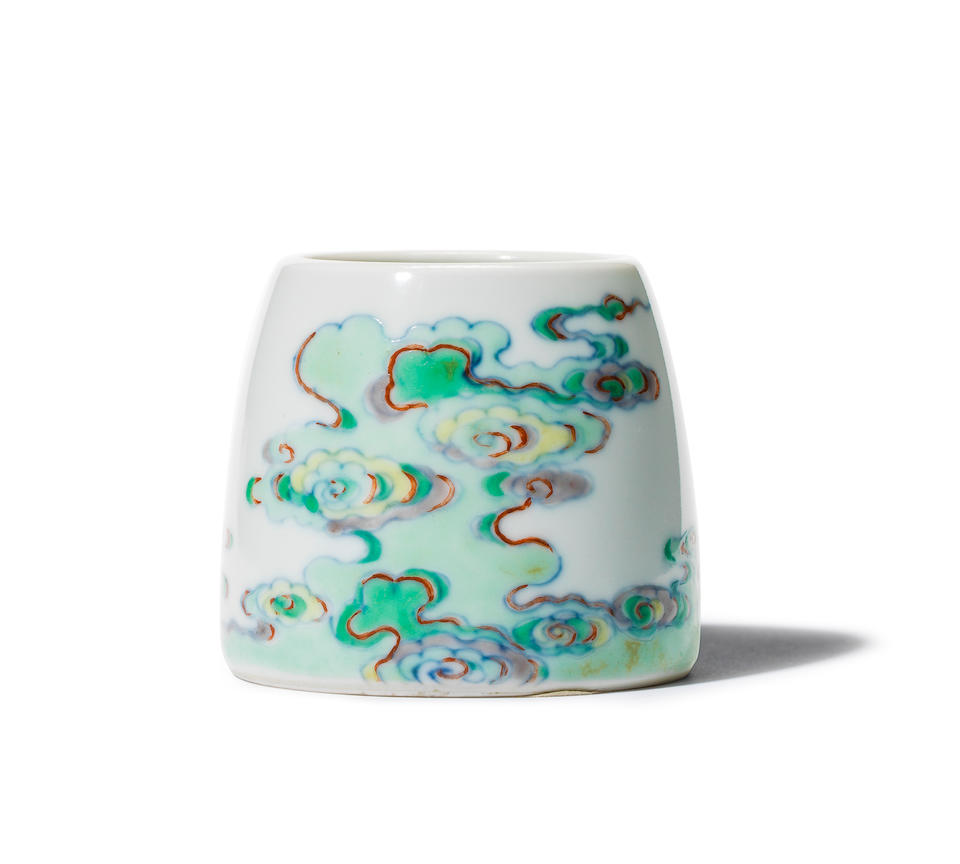
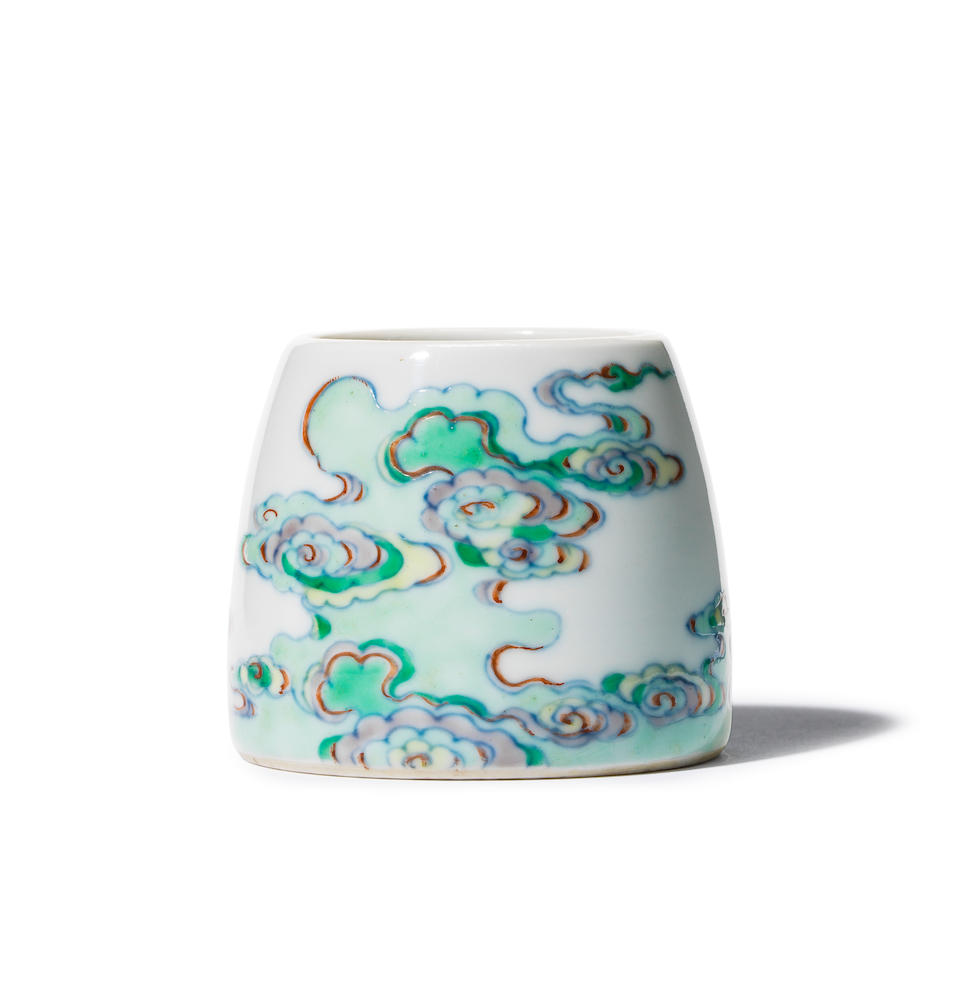
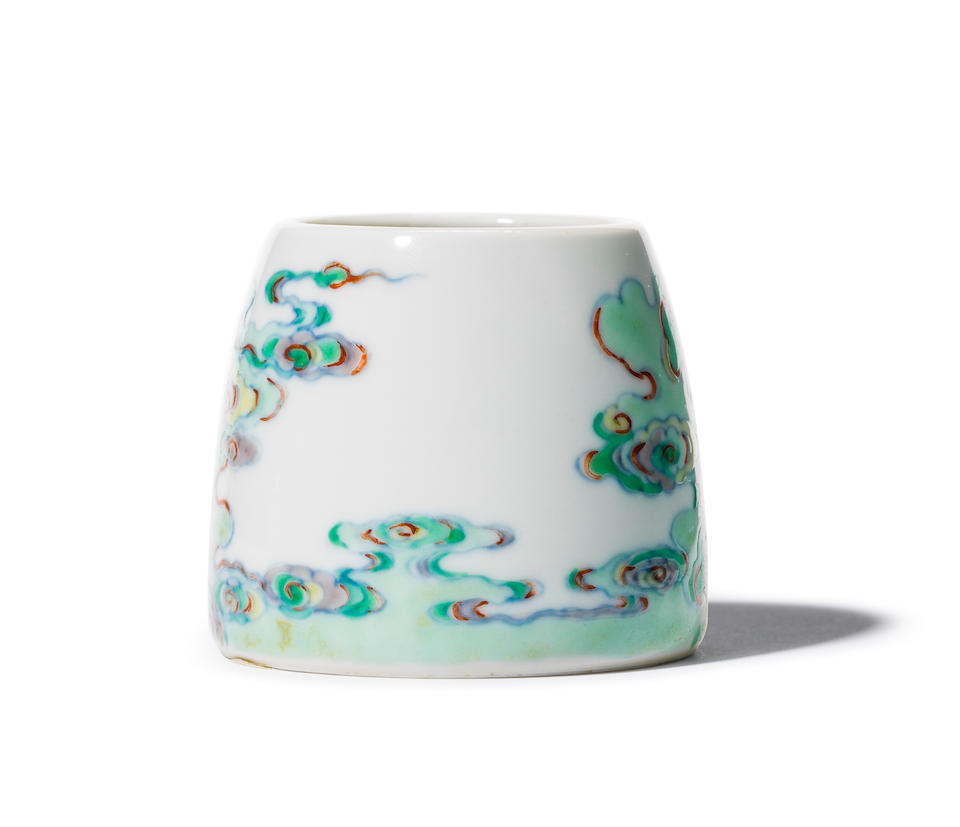

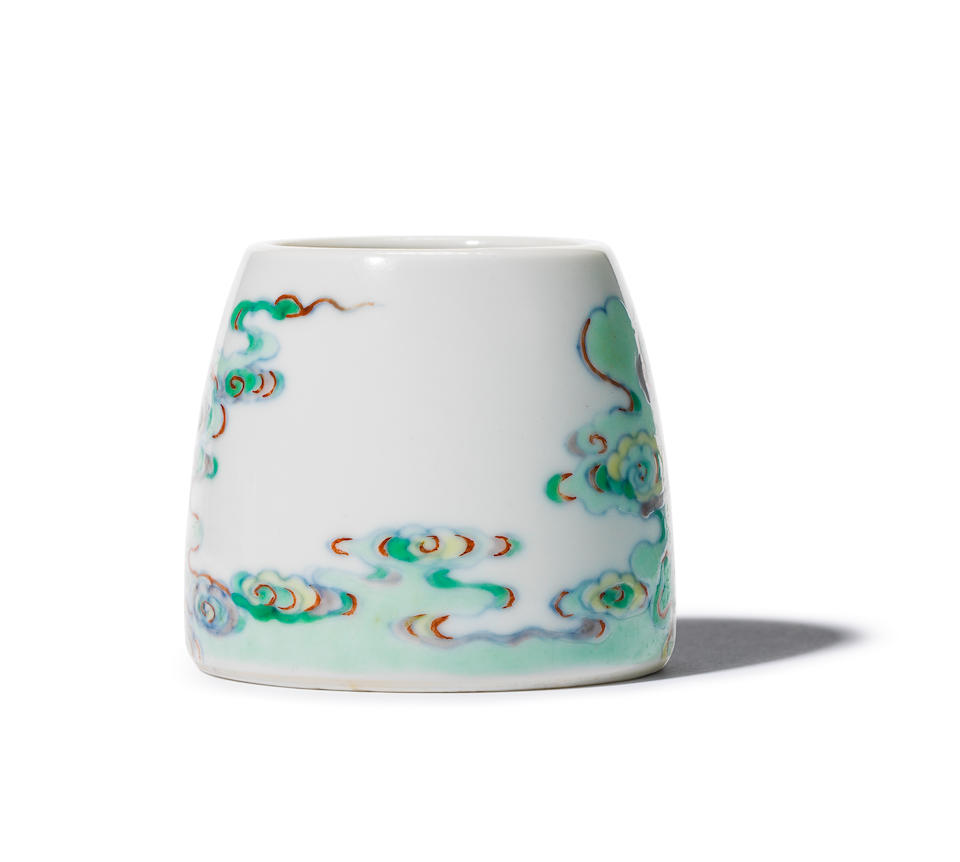
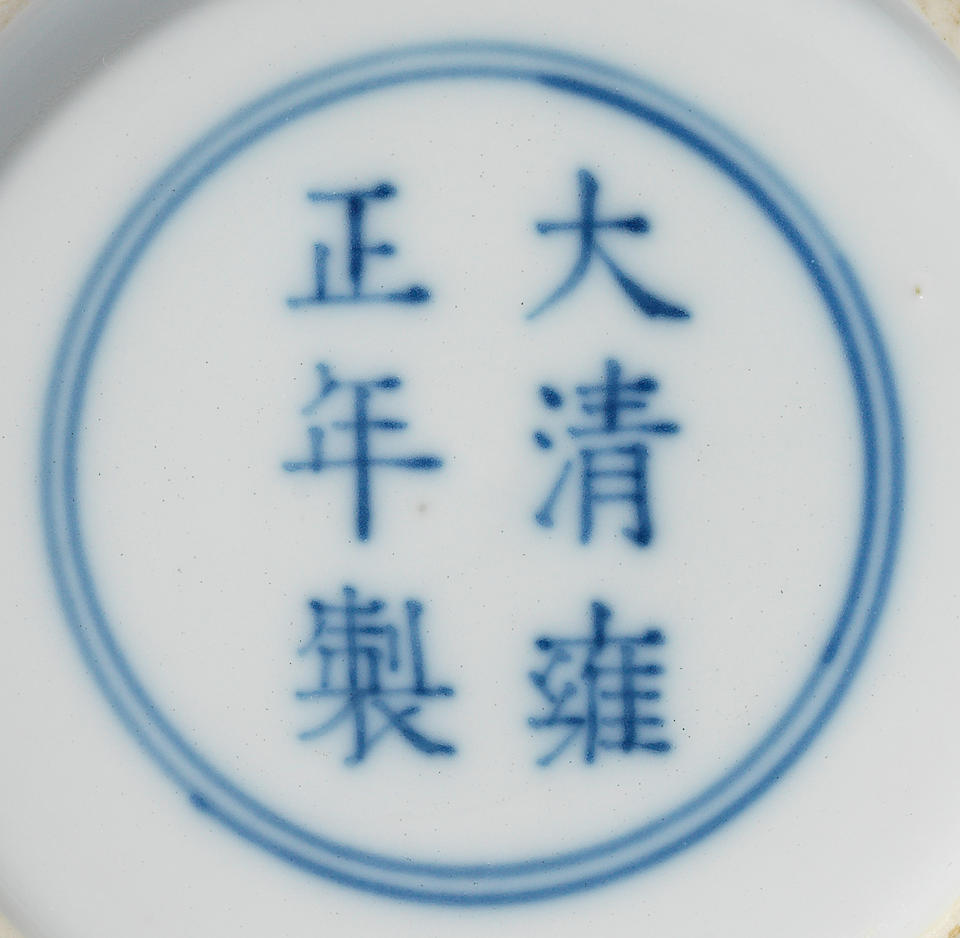
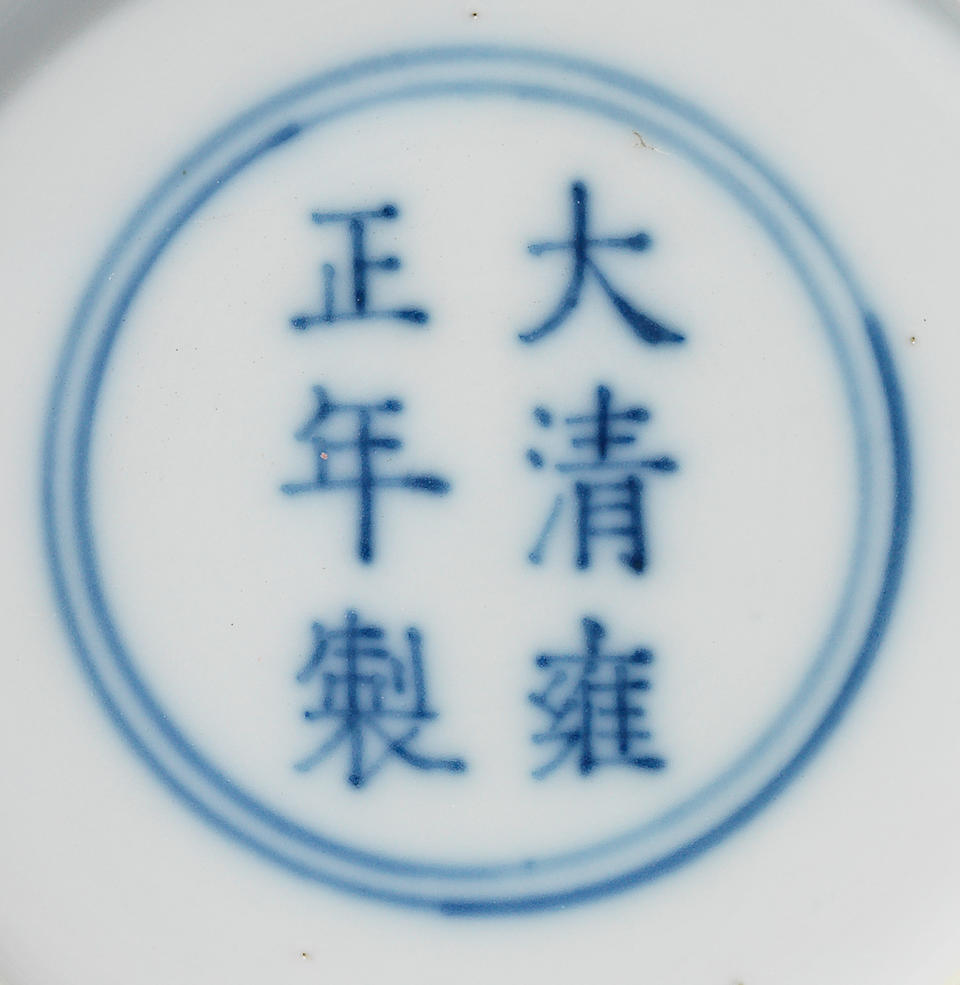
A pair of exceptionally rare Imperial doucai waterpots, Yongzheng six-character marks and of the period (1723-1735). Each: 5.3cm (2 1/8in) high. Estimate: 10,000,000-15,000,000 HKD. Sold for HK$ 12,640,000 (€1,546,158) at Bonhams Hong Kong, 2 June 2016, lot 12. Photo Bonhams.
Each gracefully potted with gently curving sides, the exterior delicately outlined in subtle underglaze-blue with vaporous swirling clouds encircling the base and rising towards the top, exquisitely enamelled in soft tones of yellow, aubergine, dark and light green, with some of the edges picked out in iron-red, the interior and base covered with a transparent glaze, the base with a six-character kaishu mark in underglaze-blue, wood stands.
Provenance: The Tsui Museum of Art, Hong Kong, 1991
The Jingguantang Collection
Christie's Hong Kong, 3 November 1998, lot 956
The Gerald M. Greenwald Collection, collection no.88
Christie's Hong Kong, For Imperial Appreciation: Fine Chinese Ceramics from the Greenwald Collection, 1 December 2010, lot 2816
An important Asian private collection.
Published and Illustrated: Min Chiu Society, Catalogue of the 7th Annual Exhibition of Porcelain of Ch'ing Dynasty. K'ang-hsi, Yung-cheng and Ch'ien-lung Periods (From 1662 to 1795AD), Hong Kong, 1968, no.57
Min Chiu Society, An Anthology of Chinese Ceramics, Hong Kong Museum of Art, Hong Kong, 1980, no.144
The Tsui Museum of Art, The Tsui Museum of Art, Hong Kong, 1991, pl.112
Chinese Ceramics. Vol.IV, The Tsui Museum of Art, Hong Kong, 1995, pl.131.
Note: The present pair of doucai waterpots is exceptionally rare and aesthetically pleasing. Only four other examples appear to have been published as follows: a single waterpot, from the Qing Court Collection, is illustrated in Small Refined Articles of the Study. The Complete Collection of Treasures of the Palace Museum, Shanghai, 2009, p.223, no.221; another single example, possibly the pair to the Palace Museum, Beijing example, is in the collection of the Nanjing Museum, illustrated in Treasures in the Royalty: The Official Kiln Porcelain of the Chinese Qing Dynasty, Shanghai, 2003, p.178 (it is interesting to note that these presumed pair of waterpots both have seemingly lighter shades of enamels and do not have red enamel highlights); and a pair of waterpots, previously in the collections of C.T.Loo, Paris, Paul and Helen Bernat, Boston, and the Shimentang collection, was sold by Eskenazi Ltd., illustrated in the catalogue Qing Porcelain from a Private Collection, London, 2012, no.3.
The Yongzheng emperor who practiced a balanced combination of Confucianism, Buddhism and Daoism, became in later life increasingly involved in Daoist matters related to the 'elixir of immortality', even bestowing upon a high official the pill of longevity. However, on 8 October 1735 he passed away, possibly as a result of consuming toxic materials contained in the 'elixir of immortality'. The Imperial pursuit of longevity and consumption of 'elixirs of immortality' is said to also have been practiced by Qinshi Huangdi (260-210 BC), China's first emperor, and by the Ming emperor Jiajing (1522-1566). In all three cases, this pursuit proved ineffective.
The power of granting the 'elixir of immortality' is attributed to the divine Daoist deity Xiwangmu, Queen Mother of the West, in whose garden, said to be hidden by high clouds in the Kunlun mountains, grow the peaches of immortality, ripening once every 3,000 years. One of the paintings in the Album of the Yongzheng Emperor in Costumes from the Palace Museum, Beijing, shows the emperor wearing a multi-coloured robe, reminiscent in colour scheme of the present pair of waterpots, offering a peach of immortality to a monkey; see E.S.Rawski and J.Rawson, eds., China: The Three Emperors 1662-1795, London, 2005, pp.167-168.
The wispy lingzhi-shaped five-coloured clouds, 'wuse yun' (五色雲) or 'qing yun' (慶雲), depicted on the present lot, represent the emperor's wish for longevity. The motif can be further interpreted as a pun on the word 'cloud', yun (雲), which is a homophone for fuyun (福運), 'good fortune'. In an agricultural society, the rain-bearing clouds would have been perceived as a benevolent omen, for the necessary irrigation of the crops.
It is interesting to note that the Yongzheng emperor seemed to have a particular fondness for the physical as well as symbolic appearance of qing yun between the 7th and the 10th year of his reign (1729 – 1732). Scenes of auspicious five-coloured clouds appearing above the sky were recorded several times in the Palace memorials presented to the emperor. The Imperial archives also recorded that paintings depicting such particular type of clouds were ordered by the Yongzheng emperor in 1730, see Lin Lina, 'Auspicious symbols and scenes of the Yongzheng period', in Feng Mingzhu, Harmony and Integrity: The Yongzheng Emperor and His Times, Taipei, 2009, pp.374 – 399.
The Yongzheng emperor's fondness for this decoration is evident in the number of extant Imperial works of art, similarly decorated with multi-coloured clouds, including the carved wooden plaque inlaid with painted enamel wispy clouds and the inscription reading 'Heed Rashness and Use Perseverance'; a painted enamel snuff bottle, Yongzheng mark and period; a painted enamel tiered box and cover, Yongzheng mark and period; and a stand with a hanging fish pendant, depicted in 'Yinzhen's [Yongzheng's] Amusements: Copying a Sutra in a Studio', illustrated in the National Palace Museum, Taipei exhibition catalogue by Feng Mingzhu, ibid., Taipei, 2009, pp.20, 116-117, 258 and 269. See also a doucai bottle vase, Yongzheng mark and period, similarly decorated with cloud scrolls, which was sold at Sotheby's Hong Kong, 8 April 2010, lot 1862.
The above examples illustrate the emperor's use of this highly particular stylised motif with which he personally identified and for decorating objects for his personal use. It is therefore not surprising that the same auspicious motif was also employed on one of the essential literati paraphernalia, especially made for the Imperial 'scholar's desk'. The very small number of extant doucai waterpots of this particular design indicates their exclusive Imperial use.
The use of this motif on a waterpot, though in a more refined and colourful palette, also presented a continuation of related waterpots made during the reign of his father, the Kangxi emperor. Such vessels were of more conical form, with carved wispy cloud scrolls, covered in white or celadon glaze; for a white-glazed example, Kangxi mark and period, see Wang Qingzheng, Kangxi Porcelain Wares from the Shanghai Museum Collection, Hong Kong, 1998, pl.227; and for a celadon-glazed example, Kangxi mark and period, from the Nanjing Museum, see Treasures in the Royalty: The Official Kiln Porcelain of the Chinese Qing Dynasty, Shanghai, 2003, p.107. However, the combined use of the doucai palette and lingzhi-shaped cloud scroll decoration was inspired by bowls from the Chenghua period; for Chenghua examples from the National Palace Museum, Taipei, see Catalogue of the Special Exhibition of Ch'eng-hua Porcelain Ware, 1465-1487, Taipei, 2003, pp.153-155 and p.156 for a Wanli example, nos.143-150.
The Yongzheng emperor personally influenced the artistic direction of the Imperial kiln production, achieving together with the celebrated kiln supervisor Tang Ying an unsurpassed standard of quality, aesthetic subtlety and refinement by merging his admiration both of classic styles of the past and of contemporary innovation. His interest in antiques, scholarly objects and curios, and arguably his wish to be identified as a cultivated literatus, is demonstrated in the scroll painting titled Guwan tu (古玩圖) or 'Record of Ancient Playthings', dated 1729, illustrated by Rawski and Rawson, ibid., pp.252-255; as well as in a number of paintings depicting him beside a scholar's desk, see Feng Minzhu, ibid., pp.115 and 117. The present pair of waterpots therefore, represents an outstanding example of the highest level of Imperial porcelain production and innovation at its zenith, realised during the Yongzheng period.
An exceptionally rare Imperial famille rose yellow-ground 'floral' bowl, Qianlong six-character mark and of the period. Sold for HK$ 4,260,000 (€521,094) at Bonhams Hong Kong, 29 Nov 2016, lot 25. Photo Bonhams.
An exceptionally rare Imperial doucai 'Eight Buddhist Emblems' stem bowl, Yongzheng six-character mark and of the period. Sold for HK$ 3,420,000 (€418,343) at Bonhams Hong Kong, 29 Nov 2016, lot 20. Photo Bonhams.
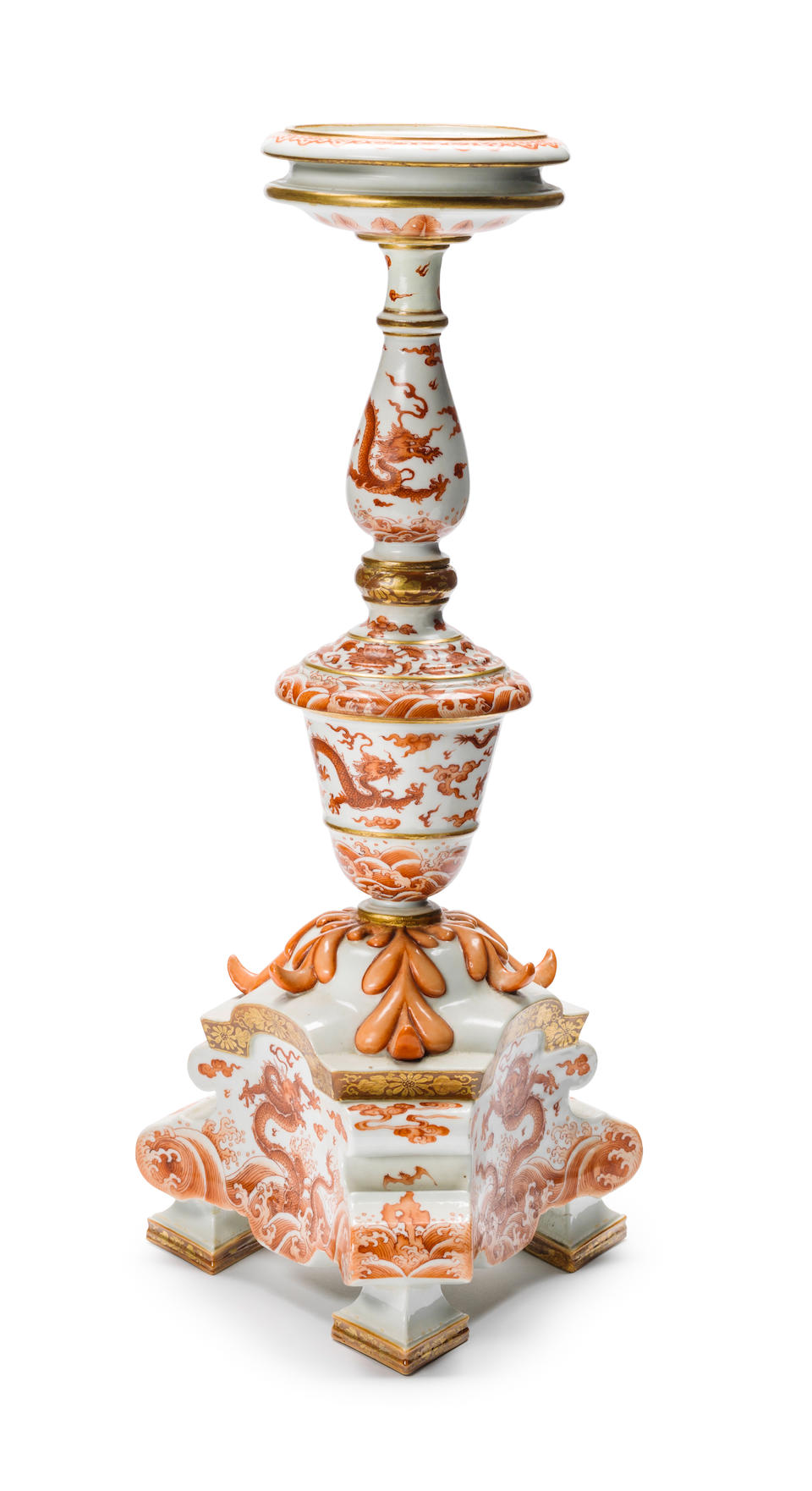
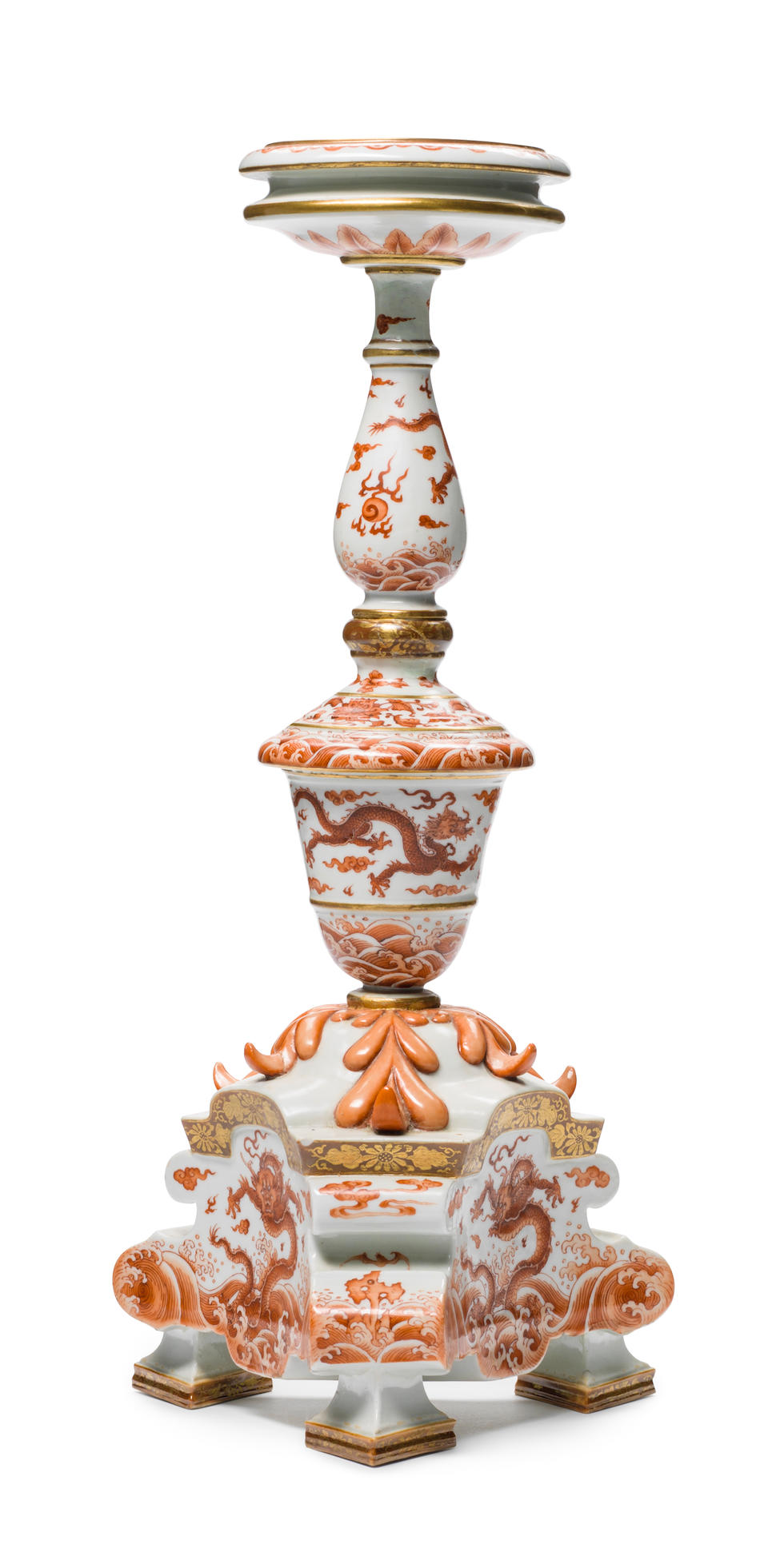
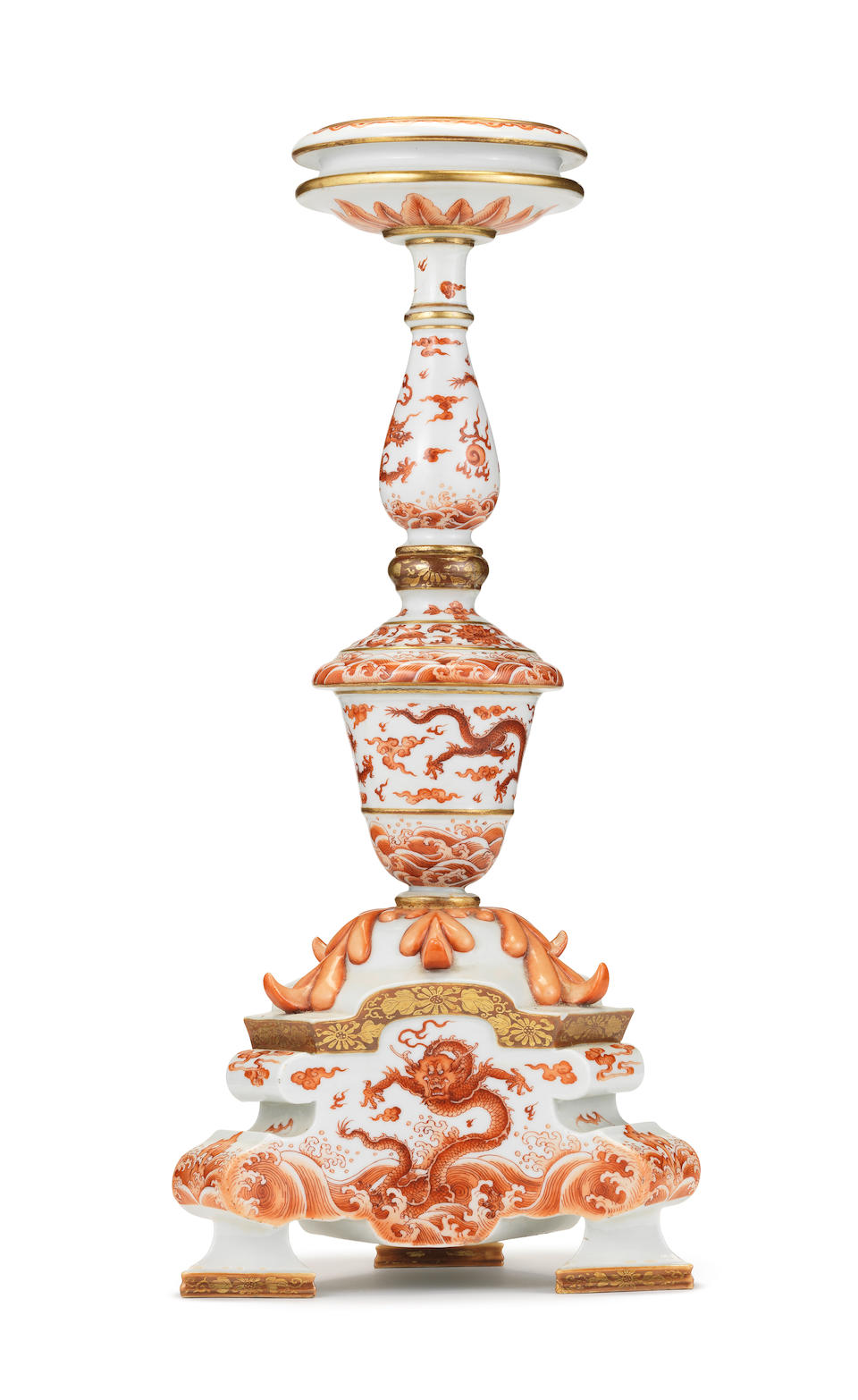
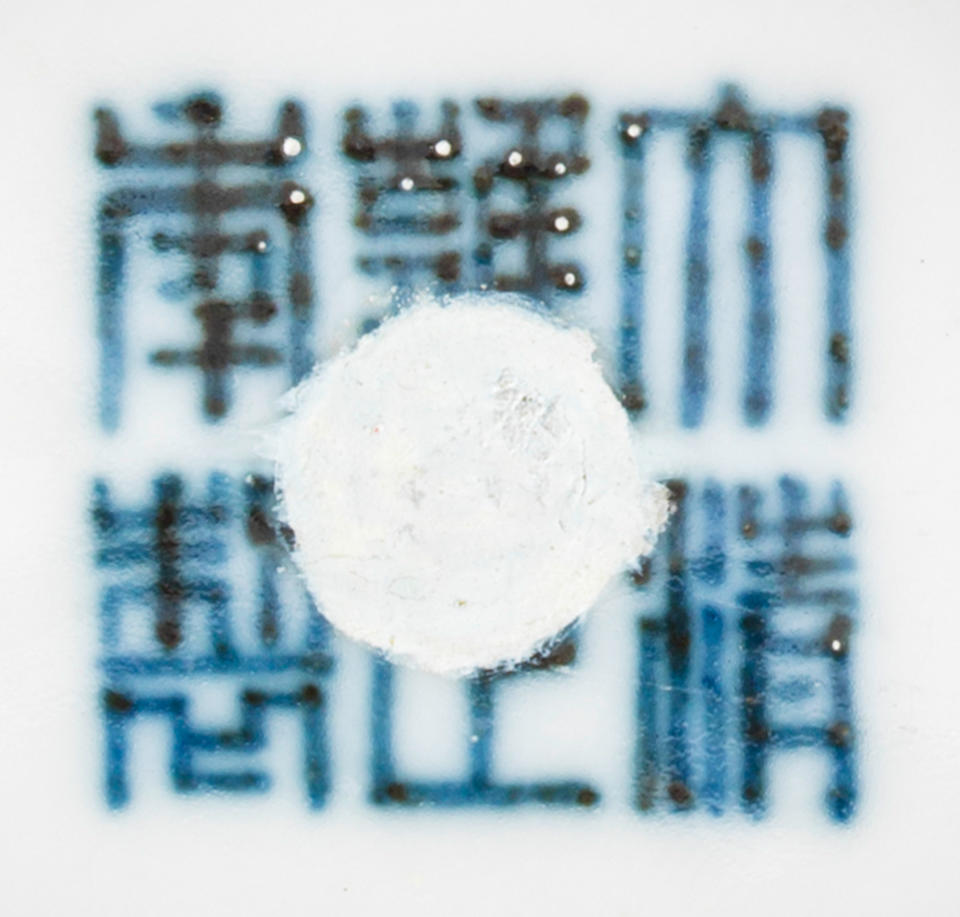
An extremely rare Imperial iron-red and gilt-decorated 'dragon' candlestick, Yongzheng seal mark and of the period (1723-1735); 42cm (16 1/2in) high. Sold for HK$ 3,040,000 (€371,860) at Bonhams Hong Kong, 2 June 2016, lot 6. Photo Bonhams.
Intricately and elegantly structured standing on a chalice-formed base with three cabriole legs, surmounted by a tall and slender stem in the form of a baluster issuing from an inverted bell-shaped section borne on a collar of elaborate leaves curving outward, supporting a wide and waisted dish-shaped drip pan, each facet of the base vividly enamelled in rich iron-red tones with a front-facing five-clawed dragon soaring ferociously amidst flames and ruyi-shaped clouds above turbulent waves, the mid-section similarly decorated with three striding dragons, each section divided by narrow bands of finely-gilt flowers on a café-au-lait ground and slim gilt borders, wood stand.
Provenance: Lieutenant-Colonel T.S.Cox and thence by descent.
Lieutenant-Colonel T.S.Cox graduated from Sandhurst Military Academy in 1892 and was commissioned in 1894 in the 16th Indian Cavalry, The Bengal Lancers. His noteworthy military service included in 1897, Tochi Field Force, N.W. Frontier; and in 1900, the China Expeditionary Force during the Boxer Rebellion, when he was awarded the US Military Order of the Dragon. In 1901 he was seconded as the Advisor to the Chinese Government and awarded an Imperial decoration by Shanqi, Prince Su (1866-1922). In 1903 he was elected to the Royal Geographical Society. In 1903 he served as Captain in the Indian Army; between 1904–1907, he was posted in the D.M.O. War Office, London, the Balkans, Asia Minor, Somaliland, Abyssinia, Russian central Asia, and Ottoman Middle East; in 1911 he was awarded the King George V Delhi Coronation Durbar medal. Between 1912-1913 he was posted in the Middle East and Central Asia. In 1915, he took part in the Gallipoli Campaign and in 1916 transferred to command the 37th Dogras. In 1917 he served in the Mesopotamian campaign and was wounded whilst serving in the Aden Field Force. In 1920 he served with the Waziristan Field Force, NW Frontier; in 1921 he transferred to command the 3rd Madras Regiment and in 1925 retired from the Indian Army as Lieutenant-Colonel.
July 1900: Cox was ordered to North China to join China Expeditionary Force to relieve the siege of the Beijing International Legation Area by Chinese 'Boxers'. Collected a troop of 16th Bengal Lancers in Hong Kong on August 15 1900 and disembarked at Sinho for Tianjin on September 11. Advanced on Beijing September/October 1900. Subsequently placed in charge of a 'Flying Column' sent to capture Boxer leaders at Baoding, a hundred miles south-west of Beijing. Campaign medal, and learned to speak Chinese. Passed 6-day Chinese language examination.
January - June 1901 worked for the British Military Commander, General Sir Alfred Gaselee, and awarded Military Order of the Dragon in April. July 1901 promoted Staff Captain and seconded to raise and train a Battalion of Chinese Railway Police, whose task was to guard the Beijing, Tongshan, and Tianjin districts for the British High Command, stationed at the Temple of Heaven in Beijing.
January 1 – December 25 1902 Cox was the Officer Commanding Railway Police, Chinese Imperial Railways, most of this time under contract to the Chinese Imperial Government. In addition to this role, from June 1 to December 1902 he was 'Confidential Adviser' to His Imperial Highness Prince Su, Governor of Beijing (the Emperors uncle), and from August 15 to December 1902 also 'Confidential Adviser' to His Imperial Highness Prince Qing, Head of Chinese Octroi (Customs) Department. Cox received a Letter of Appreciation and was awarded a Chinese Imperial Decoration for his services. He left Beijing for India on December 25 1902.
Note: The present lot is exceedingly rare and no other example appears to have been published. It embodies the height of Qing dynasty porcelain production, reaching its zenith in quality and innovation under the supervision of the celebrated master potter, Tang Ying (1682-1756) and the guidance of the Yongzheng emperor. The complexity of its form and vulnerability underlines the rarity of this lot and the importance of its existence, having been safeguarded for over one hundred years.
In form, the most comparable example is that of a famille rose moulded candlestick, Yongzheng four-character mark and period, which was sold at Christie's London on 8 November 2011, lot 406, and later sold at Poly Auction, Beijing, on 6 June 2015, lot 6330. The rare famille rose moulded example, formed part of a five-piece garniture, comprising an incense burner, two vases and two candlesticks; see Christie's London, 7 April 1982, lot 62, for an example of a three-piece famille rose moulded part-set, Yongzheng mark and period, comprising an incense burner and two vases. The only other known candlestick of the famille rose moulded type, is the extant lower section, which was sold in our London rooms on 5 November 2009, part lot 195. Similarly, it is possible that the present lot would have been part of a five-piece garniture set, as may be indicated by a similarly decorated iron-red enamelled 'dragon' hexagonal vase, Yongzheng, with similar design with fiery dragons amidst flames and clouds above crashing waves, which was sold at Sotheby's Hong Kong on 8 October 2014, lot 3706, although this example unlike the present lot and the famille rose moulded examples, does not bear a Yongzheng mark.
Tang Ying, a bondservant of the Plain White Banner at the Imperial Household Department, had served at the court in Beijing from the age of 16. Before he became a master potter, he had already been well versed in painting and calligraphy – accomplishments that helped him later in his career to boost the quality of porcelain decoration at the Imperial kilns. While still serving the court in Beijing, the Yongzheng emperor already had him create designs for porcelains produced at Jingdezhen. In 1726 he was sent to supervise the Jingdezhen Imperial kilns personally, and continued his services during the Qianlong emperor's reign. In his innovations, Tang Ying turned to Chinese antiquity for inspiration, but also to the exotic influence of the West, which began with the Kangxi emperor's fascination with scientific instruments and technological advancements brought to the Imperial court by Jesuit priests and artisans, but also continued during the following Yongzheng and Qianlong reigns. According to the official list from 1735, recorded on the Taocheng jishi bei ji [Commemorative Stele on Ceramic Production] composed by Tang Ying, an order from the Yongzheng emperor was noted: 'Imitate the Western cast vessels, (including) five-piece altar sets, dishes, vases etc., paint to render (effect), also emulate the Western painting style'.
The Yongzheng emperor's fascination with the West is aptly demonstrated in the commissioned portrait showing the emperor in a European outfit, reinforcing the Imperial image of ruler of 'all under heaven'; see A.Jackson and A.Jaffer, eds., Encounters: The Meeting of Asia and Europe 1500-1800, London, 2004, p.8. The modelling of the present lot, influenced in form by European silver candlesticks, yet adorned with the Imperial five-clawed dragons amidst clouds and above breaking waves, islands and bats, provides a cultural link between East and West, the emperor and the European influence on Chinese aesthetics.
A pair of magnificent and rare large Imperial yellow-glazed incised 'Auspicious Emblems' dishes, Yongzheng six-character marks and of the period. Sold for HK$ 1,980,000 (€242,198) at Bonhams Hong Kong, 29 Nov 2016, lot 175. Photo Bonhams.
A polychrome enameled plaque, Wang Qi, dated by inscription to 1928. Sold for US$ 187,500 (€177,876) at Bonhams San Francisco, 21 Dec 2016, lot 8191. Photo Bonhams.
A rare Imperial famille rose 'chilong' bottle vase, Qianlong seal mark and of the period. Sold for £110,500 (€129,061) at Bonhams London, 10 Nov 2016, lot 79. Photo Bonhams.

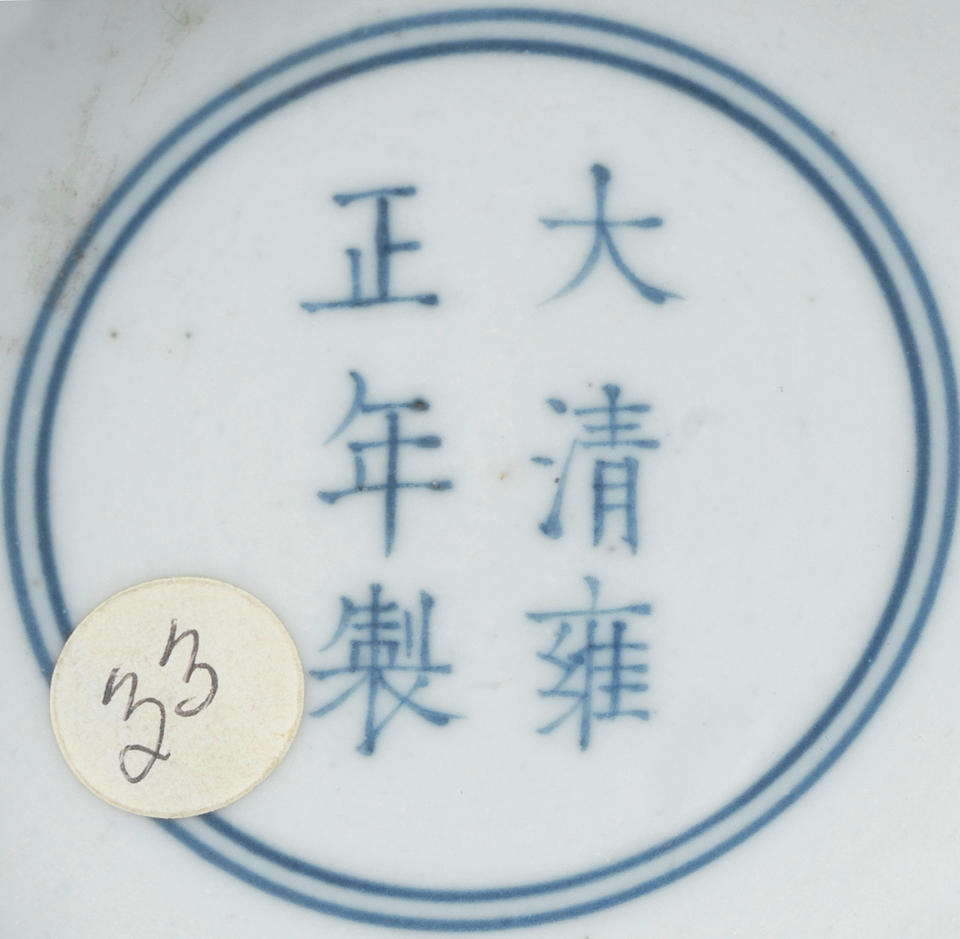
A rare copper-red glazed vase, meiping, Yongzheng six-character mark and of the period (1723-1735); 22.3cm (8 3/4in) high. Sold for HK$ 1,000,000 (€122,322) at Bonhams Hong Kong, 2 Jun 2016, lot 11. Photo Bonhams.
Of baluster form, rising from a slightly flared foot to high rounded shoulders, surmounted by a waisted neck and rounded mouth rim, the rich liver-red glaze applied evenly, stopping neatly at the white-glazed rim and above the foot ring, wood stand.
Provenance: An English private collection, and thence by descent.
Note: The rich even deep jihong glaze on the present vase is a continuation of the underglaze-copper-red glazes produced from the Yuan dynasty and the early Ming dynasty, particularly during the Hongwu and Xuande reigns, offering a challenge for the potters. The underglaze-red glaze, also known as 'sacrificial' red, was revived during the Kangxi period, when the langyao or sang-de-boeuf glazes were created by the Imperial kiln supervisor Lang Tingji (1663-1715) alongside the peachbloom glaze. Copper-red glazes continued into the Yongzheng period, with further innovations such as the flambé glaze. The Yongzheng emperor was personally involved with the production of the Imperial kiln; dissatisfied with the thinness of the sacrificial red glaze on some newly made vessels, he is recorded to have sent on the 14th day of the 8th month of the 7th year (corresponding to 1729) five shards with thick sacrificial red glaze to Nian Xiyao for future reference; see The Tsui Museum of Art: Chinese Ceramics IV, Qing Dynasty, Hong Kong, 1995, pp.47 and 81 note 11.
A related red-glazed meiping, Yongzheng mark and period, of slightly larger size, is illustrated in The Complete Collection of Treasures of the Palace Museum: Monochrome Porcelain, Hong Kong, 1999, pl.24. The use of the copper-red, or 'sacrificial' red glaze, continued into the Qianlong reign; for a related meiping, Qianlong seal mark and period, see The Tsui Museum of Art: Chinese Ceramics IV, Qing Dynasty, Hong Kong, 1995, pl.39.
Compare a related copper-red glazed meiping, Yongzheng mark and period, which was sold at Sotheby's Hong Kong on 6 April 2016, lot 3637; and see two other copper-red glazed meiping, Yongzheng marks and period, from the T.Y.Chao collection, sold at Christie's Hong Kong, 1 June 2011, lots 3613 and 3614.
A very rare blue and white 'lotus' bowl, lianzi wan, Yongle period, from the Cunliffe Collection. Sold for £98,500 (€115,045) at Bonhams London, 10 Nov 2016, lot 38. Photo Bonhams.

/https%3A%2F%2Fprofilepics.canalblog.com%2Fprofilepics%2F1%2F0%2F100183.jpg)
/https%3A%2F%2Fstorage.canalblog.com%2F03%2F02%2F119589%2F96711876_o.jpg)
/https%3A%2F%2Fstorage.canalblog.com%2F11%2F31%2F119589%2F94773502_o.jpg)
/https%3A%2F%2Fstorage.canalblog.com%2F20%2F83%2F119589%2F94772815_o.jpg)
/https%3A%2F%2Fstorage.canalblog.com%2F26%2F72%2F119589%2F75604929_o.jpg)
/https%3A%2F%2Fstorage.canalblog.com%2F59%2F60%2F119589%2F26458628_o.jpg)

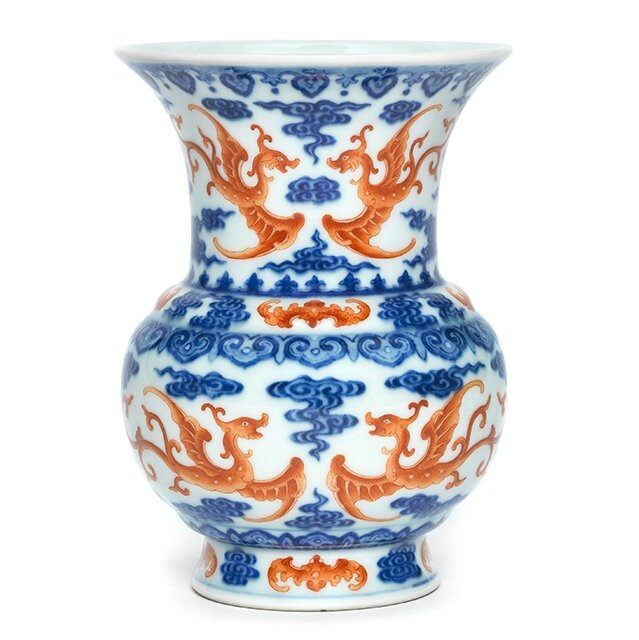






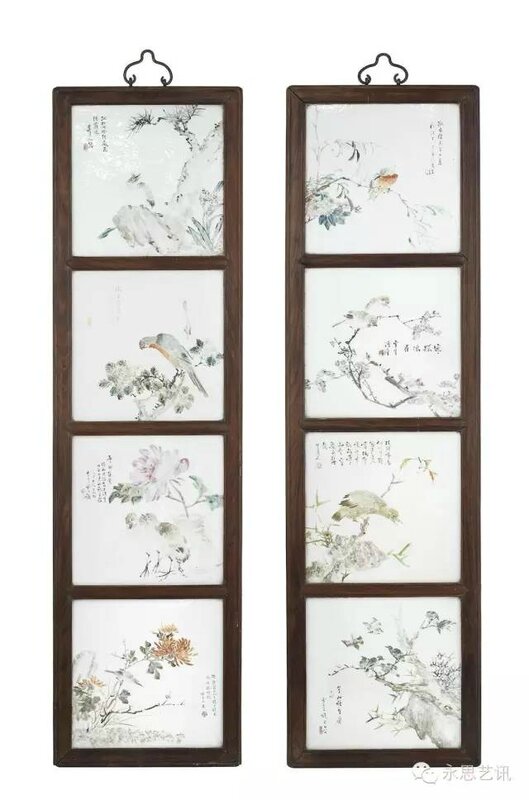




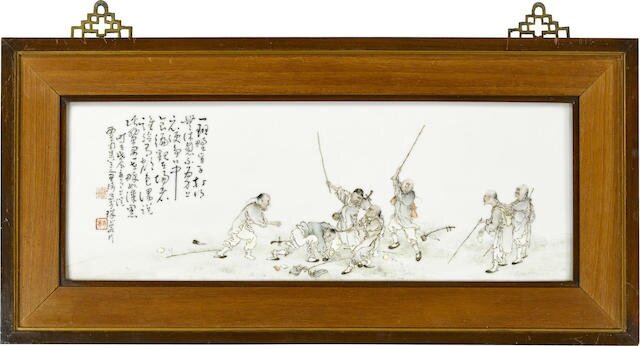




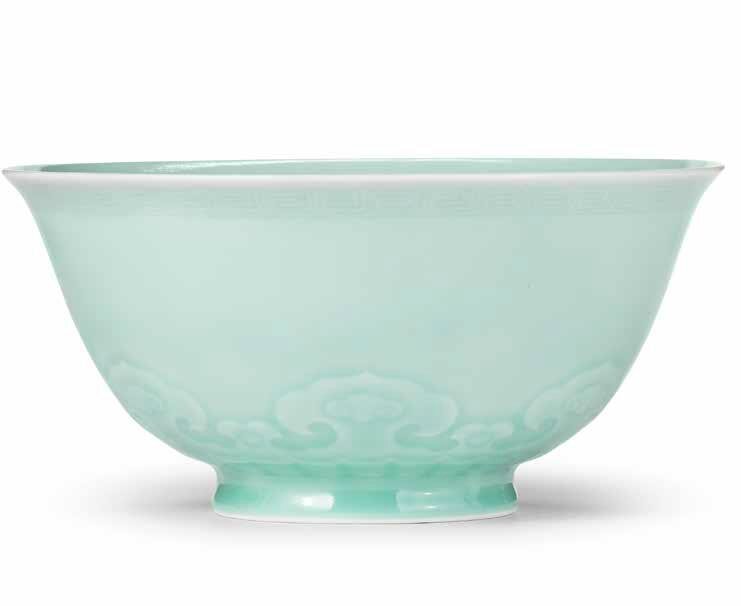


/image%2F1371349%2F20240416%2Fob_2a8420_437713933-1652609748842371-16764302136.jpg)
/image%2F1371349%2F20240414%2Fob_83ee65_2024-nyr-22642-0954-000-a-blue-and-whi.jpg)
/image%2F1371349%2F20240414%2Fob_15808c_2024-nyr-22642-0953-000-a-blue-and-whi.jpg)
/image%2F1371349%2F20240414%2Fob_e54295_2024-nyr-22642-0952-000-a-rare-blue-an.jpg)